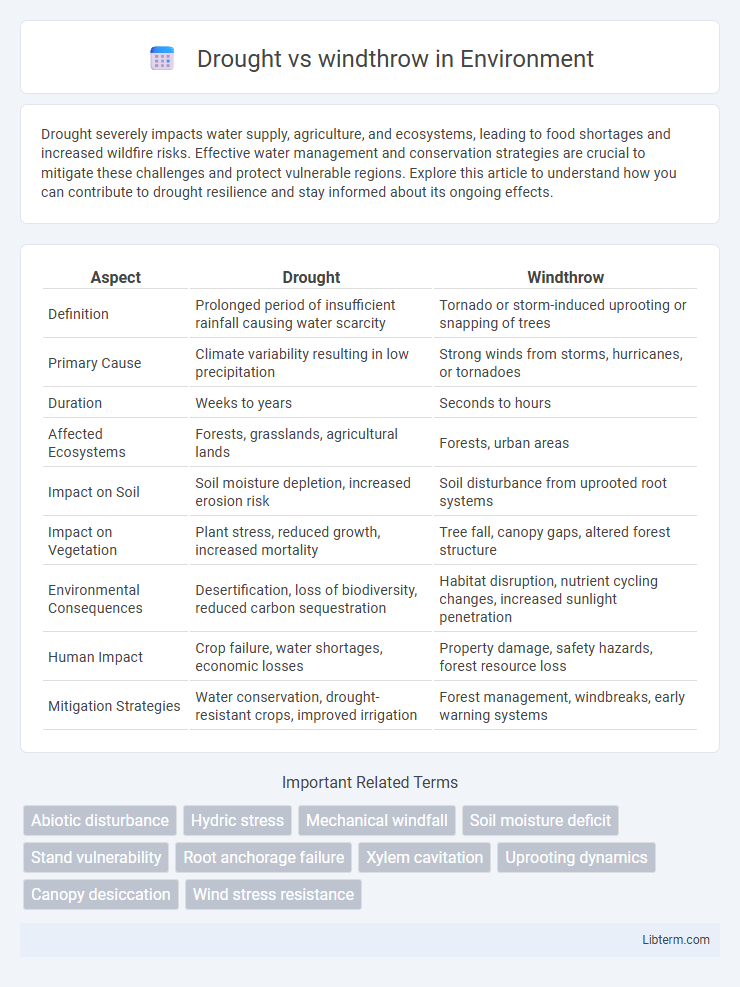Drought severely impacts water supply, agriculture, and ecosystems, leading to food shortages and increased wildfire risks. Effective water management and conservation strategies are crucial to mitigate these challenges and protect vulnerable regions. Explore this article to understand how you can contribute to drought resilience and stay informed about its ongoing effects.
Table of Comparison
| Aspect | Drought | Windthrow |
|---|---|---|
| Definition | Prolonged period of insufficient rainfall causing water scarcity | Tornado or storm-induced uprooting or snapping of trees |
| Primary Cause | Climate variability resulting in low precipitation | Strong winds from storms, hurricanes, or tornadoes |
| Duration | Weeks to years | Seconds to hours |
| Affected Ecosystems | Forests, grasslands, agricultural lands | Forests, urban areas |
| Impact on Soil | Soil moisture depletion, increased erosion risk | Soil disturbance from uprooted root systems |
| Impact on Vegetation | Plant stress, reduced growth, increased mortality | Tree fall, canopy gaps, altered forest structure |
| Environmental Consequences | Desertification, loss of biodiversity, reduced carbon sequestration | Habitat disruption, nutrient cycling changes, increased sunlight penetration |
| Human Impact | Crop failure, water shortages, economic losses | Property damage, safety hazards, forest resource loss |
| Mitigation Strategies | Water conservation, drought-resistant crops, improved irrigation | Forest management, windbreaks, early warning systems |
Introduction to Drought and Windthrow
Drought significantly reduces soil moisture, stressing trees by limiting water availability and leading to weakened root systems. Windthrow occurs when strong winds uproot or break trees, often targeting those with compromised stability from factors like drought stress. Both phenomena critically impact forest ecosystems, influencing tree health and increasing vulnerability to further environmental disturbances.
Defining Drought: Causes and Characteristics
Drought is defined by prolonged periods of below-average precipitation, leading to water scarcity that impacts soil moisture, plant health, and ecosystem stability. Its causes include natural climate variability, atmospheric circulation patterns like La Nina, and human-induced factors such as deforestation and climate change. Characteristics of drought involve reduced groundwater recharge, increased temperature and evapotranspiration rates, and heightened vulnerability of vegetation to stress and mortality.
Understanding Windthrow: Triggers and Impacts
Windthrow occurs when strong winds uproot or snap trees, often targeting shallow-rooted species after environmental stresses like drought. Drought weakens tree root systems by limiting water availability, reducing anchorage and making trees more susceptible to windthrow during storms. The combined impact results in increased forest damage, loss of biomass, and disrupted ecosystems, emphasizing the need for monitoring drought conditions and wind exposure in forest management.
Ecological Consequences of Drought
Drought significantly disrupts water availability, leading to reduced soil moisture and impaired tree physiology, which decreases forest resilience and increases vulnerability to pests and diseases. Prolonged drought conditions weaken root systems, making trees more susceptible to windthrow by reducing anchorage strength. The ecological consequences include altered species composition, decreased biodiversity, and impaired carbon sequestration, ultimately affecting ecosystem stability and function.
Environmental Effects of Windthrow
Windthrow causes extensive damage to forest ecosystems by uprooting or snapping trees, leading to habitat loss and increased vulnerability to soil erosion. This disturbance disrupts nutrient cycling and alters microclimates, often resulting in decreased biodiversity and changes in species composition. The exposure of soil increases runoff and sedimentation in nearby water bodies, negatively impacting aquatic habitats and water quality.
Comparative Analysis: Drought vs Windthrow
Drought and windthrow both severely impact forest ecosystems but differ fundamentally in their causes and effects; drought induces stress by limiting water availability, leading to reduced growth, increased vulnerability to pests, and potential tree mortality. Windthrow abruptly uproots or breaks trees during storms, altering forest structure and creating gaps that influence species composition and regeneration. Comparative analysis reveals drought effects are often gradual and prolonged, while windthrow causes immediate physical damage, yet both disturbances interact by weakening tree resilience and affecting forest dynamics.
Forest Vulnerability and Resilience
Drought significantly reduces forest resilience by impairing water availability, weakening tree physiology, and increasing susceptibility to pests and diseases, thereby heightening forest vulnerability. Windthrow, caused by strong winds uprooting or snapping trees, disrupts forest structure and canopy cover, altering microclimates and soil stability, which can either degrade or promote forest recovery depending on severity and species composition. Understanding the interplay between drought stress and windthrow events is crucial for managing forest vulnerability and enhancing ecosystem resilience in changing climate conditions.
Management Strategies for Drought
Effective drought management strategies prioritize soil moisture conservation through mulching and drip irrigation to maintain tree health and reduce water stress. Selecting drought-resistant tree species and implementing timely thinning can improve forest resilience against prolonged dry periods. Monitoring soil moisture and adjusting management practices accordingly ensures optimal resource use and minimizes drought-induced damage.
Windthrow Mitigation and Prevention
Windthrow mitigation and prevention focus on strengthening tree root systems and enhancing forest stand stability through selective thinning and mixed-species planting to reduce susceptibility to strong winds. Implementing proper forest management practices such as maintaining optimal tree spacing, controlling tree height and crown structure, and avoiding soil compaction helps minimize windthrow risks. Monitoring weather patterns and applying early-warning systems enable proactive responses to severe wind events, thereby protecting forest health and productivity.
Future Outlook: Adapting to Climatic Extremes
Future outlooks for drought and windthrow emphasize the need for resilient forest management strategies that incorporate climate-adaptive species selection and improved soil moisture conservation techniques. Predictive models indicate an increased frequency of drought stress and windthrow events due to intensified storms and prolonged dry periods driven by climate change. Integrating remote sensing technology and real-time environmental monitoring can enhance early warning systems, supporting proactive responses to mitigate damage and sustain ecosystem health.
Drought Infographic

 libterm.com
libterm.com